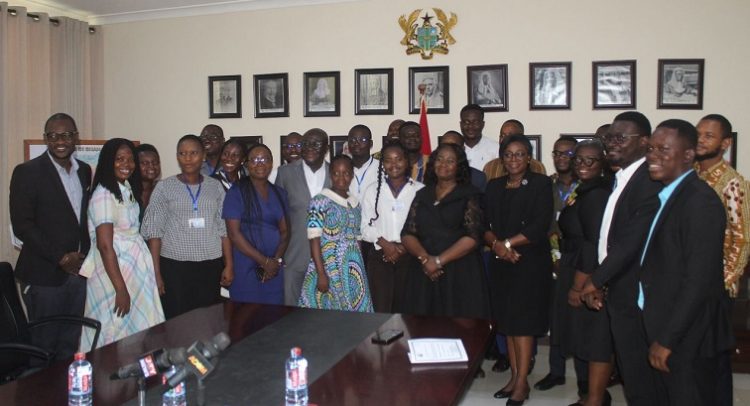
By Kenneth Owusu Asante AMPONSAH
A bank’s balance sheet is only as strong as the environment it depends on.
Climate change has moved from a distant global conversation to a daily Ghanaian reality. From the choking red rivers of the Western Region to the eroded farmlands of the Ashanti and Eastern Regions, illegal small-scale mining, popularly known as galamsey, has left visible scars on our land, water, and livelihoods.
But beneath the environmental and social consequences lies a less visible danger. A financial stability crisis in the making. For a sector built on confidence, sustainability, and predictability, unchecked ecological degradation has now become a credit, liquidity, and systemic risk issue.
Let’s start with the economic toll of galamsey on the economy.
According to data from the Ghana Chamber of Mines and the Ministry of Lands and Natural Resources (2024), small-scale mining (both legal and illegal) produced about 1.2 million ounces of gold in 2024, surpassing 2023’s total output. It is estimated that 70–80% of these operations were unregulated, evading taxation and environmental controls.
The financial losses are immense. Ghana forfeits about US$2billion annually in uncollected revenue from illegal mining activities while over 190,000 acres of cocoa farms, which serves as a cornerstone of Ghana’s foreign exchange, have been destroyed or rendered unproductive.
For banks, this translates into declining borrower productivity, impaired collateral values, and increased default risks. Galamsey is not only destroying our rivers, but also quietly eroding bank balance sheets.
What happens when nature hits the numbers?
The environmental crisis compounds Ghana’s broader climate vulnerabilities. Rising temperatures, erratic rainfall, and flooding have worsened soil erosion and crop failure, amplifying physical risks for borrowers.
For financial institutions, this manifests in higher non-performing loans (NPLs), reduced collateral recovery, and potential capital erosion. In parallel, transition risks stemming from tightening environmental laws, global investor scrutiny, and ESG expectations are rising sharply.
Banks exposed to clients engaged in unsustainable practices may soon face reputational, compliance, and funding risks, especially as climate-conscious investors and correspondent banks tighten their screening processes.
On the regulatory standpoint, the response has shifted from awareness to action.
The Bank of Ghana’s Climate-Related Financial Risk Directive (November 2024), which takes effect from January 2026, is a landmark in Ghana’s financial regulatory evolution. It mandates banks to integrate climate risk into their governance, credit assessment, capital, and disclosure frameworks.
Complementing this, the Ghana Green Taxonomy Framework by the Ministry of Finance defines sustainable economic activities and provides a classification system for green lending. Together, these frameworks signal a transition from voluntary environmental policies to mandatory prudential climate governance.
At the policy & product level, banks can lead the change by integrating environmental risk into credit decisions and capital charge estimation.
Banks must treat environmentally degraded areas as high-risk credit zones. Environmental due diligence should become a prerequisite for loans linked to mining, agriculture, or real estate projects.
Credit appraisals must include environmental impact and land-use assessments, water-quality verification reports, and climate scenario stress testing for repayment capacity. This approach ensures banks do not inadvertently finance ecological destruction while preserving long-term asset quality.
Banks should also consider adjusting capital and provisions for climate-linked losses. The IFRS 9 framework already embeds forward-looking provisioning. The next evolution is integrating climate and galamsey risk indicators into Expected Credit Loss (ECL) models. Borrowers operating in environmentally vulnerable zones should attract higher probability of default (PD) and loss given default (LGD) parameters. Over time, the regulator could encourage the creation of climate risk capital buffer which would be a dedicated reserve to absorb environment-related shocks.
Beyond policy and products, real impact will come from how banks control the flow of funds.
Financial institutions must ensure that neither lending nor deposits become indirect enablers of illegal mining. In our quest to strengthen bank controls and lending integrity, Banks should conduct enhanced environmental due diligence before approving financing for asset purchases, such as heavy-duty equipment, excavators, and generators, that could be diverted into illegal mining operations. Each asset-based facility should clearly define the purpose, operational site, and ownership of the financed equipment.
Again, loan proceeds must be tracked to ensure they are used strictly for the approved purpose. Disbursements to sectors susceptible to environmental abuse should be done on a controlled or phased basis, with supporting invoices and site verifications before each tranche.
Beyond standard KYC, banks should perform Know-Your-Supplier (KYS) and Enhanced Due Diligence (EDD) on both the borrower and the ultimate use of proceeds. For example, if deposits or inflows are traceable to gold exports, banks must confirm that the proceeds originate from licensed dealers or legitimate export channels.
Finally, banks should strengthen transaction monitoring systems to detect patterns consistent with illegal mining proceeds, such as unusually high cash deposits from rural mining areas or accounts receiving bulk inflows with no documented trade background. Any red flags must trigger immediate internal review and, if necessary, a Suspicious Transaction Report (STR).
At first glance, the link between galamsey and bank stability may seem distant.
Yet when farmlands die, rivers dry up, and communities collapse, banks lose both borrowers and deposits. Environmental degradation transforms into financial contagion through reduced income, asset devaluation, and credit defaults.
The World Bank estimates that climate-induced shocks could reduce Ghana’s GDP by up to 3% annually by 2050 if unmitigated. For a banking sector dependent on growth and liquidity stability, the message is clear. Ignoring environmental risk is not prudence, it’s peril.
The future stability of Ghana’s financial system is intertwined with the health of its environment.
Banks are uniquely positioned to redirect capital from destruction to regeneration by financing sustainable enterprises, embedding environmental due diligence, and leading public-private partnerships that rebuild ecosystems.
This is not a call for charity. It’s a call for foresight. The environment sustains the economy, and the economy sustains the bank.
In the end, protecting rivers, forests, and communities is as vital as protecting capital.
The post A crisis beneath our feet (climate risk, galamsey, and financial stability): Can banks be part of the solution? appeared first on The Business & Financial Times.
Read Full Story
























Facebook
Twitter
Pinterest
Instagram
Google+
YouTube
LinkedIn
RSS